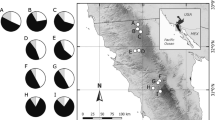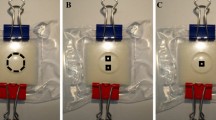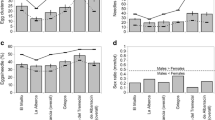Abstract
In the aggregation theory, aggregation of eggs is one of important conditions for the coexistence of species. However, aggregation of eggs by clutch laying does not always promote coexistence, whereas aggregation of eggs by aggregated distributions of ovipositing females always has a significant contribution to the coexistence. In this study, spatial distributions of three Drosophila species across naturally occurring cherry fruits were studied with relation to their clutch sizes. Drosophila suzukii oviposited eggs mainly on fresh fruits on trees, and its eggs were randomly distributed across cherry fruits. The emergence data also indicated random spatial distributions of this species. Random egg distributions of this species are explained by random visits of females to fruits and the production of clutches of mostly single eggs. On the other hand, D. lutescens and D. rufa oviposited on fallen fruits, showed aggregated distributions in the emergence data, and frequently produced clutches of a few eggs. In these species, the degree of aggregation was usually significantly lower than the expectation based on random visits of females to fruits and their clutch sizes observed in the present experiments, indicating that their aggregation is unlikely to arise from aggregated distributions of ovipositing females. Thus, the spatial aggregation of these species does not necessarily lead to their coexistence.


Similar content being viewed by others
References
Atkinson WD, Shorrocks B (1981) Competition on a divided and ephemeral resource: a simulation model. J Anim Ecol 50:461–471
Green RF (1986) Does aggregation prevent competitive exclusion? A response to Atkinson and Shorrocks. Am Nat 128:301–304
Green RF (1988) Reply to Shorrocks and Rosewell. Am Nat 131:772–773
Hanski I (1981) Coexistence of competitors in patchy environment with and without predation. Oikos 37:306–312
Hanski I (1987) Carrion fly community dynamics: patchiness, seasonality and coexistence. Ecol Entomol 12:257–266
Hartley S, Shorrocks B (2002) A general framework for the aggregation model of coexistence. J Anim Ecol 71:651–662
Heard SB, Remer LC (1997) Clutch-size behavior and coexistence in ephemeral-patch competition models. Am Nat 150: 744–770
Hoffmeister TS, Rohlfs M (2001) Aggregative egg distributions may promote co-existence: but why do they exist? Evol Ecol Res 3:37–50
Ives AR (1988) Aggregation and the coexistence of competitions. Ann Zool Fenn 23:75–88
Ives AR (1991) Aggregation and coexistence in a carrion fly community. Ecol Monogr 61:75–94
Jaenike J, James AC (1991) Aggregation and the coexistence of mycophagous Drosophila. J Anim Ecol 60:913–928
Mitsui H, Kimura MT (2000a) Coexistence of drosophilid flies: aggregation, patch size diversity and parasitism. Ecol Res 15:93–100
Mitsui H, Kimura MT (2000b) Food preference of drosophilid flies in domestic and forest areas of central Japan. Entomol Sci 3:285–289
Nishiharu S (1980) A study of ecology and evolution of drosophilid flies with special regard to imaginal and larval feeding habits and seasonal population fluctuations. PhD Thesis, Tokyo Metropolitan University, Tokyo
Rohlfs M, Obmann B, Petersen R (2005) Competition with filamentous fungi and its implication for a gregarious lifestyle in insects living on ephemeral resources. Ecol Entomol 30:556–563
Rosewell J, Shorrocks B, Edwards K (1990) Competition on a divided and ephemeral resource: testing the assumption. I. Aggregation. J Anim Ecol 59:977–1001
Sevenster JG (1996) Aggregation and coexistence. I. Theory and analysis. J Anim Ecol 65:297–307
Sevenster JG, van Alphen JJM (1996) Aggregation and coexistence. II. A neotropical Drosophila community. J Anim Ecol 65:308–324
Takahashi KH, Tuno N, Kagaya T (2005) The relative importance of spatial aggregation and resource partitioning on the coexistence of mycophagous insects. Oikos 109:125–134
Toda MJ, Kimura MT, Tuno N (1999) Coexistence mechanisms of mycophagous drosophilids on multi-species fungal hosts: aggregation and resource partitioning. J Anim Ecol 68:794–803
Wertheim B, Dicke M, Vet LEM (2002) Behavioural plasticity in support of a benefit for aggregation pheromone use in Drosophila melanogaster. Entomol Exp Appl 103:61–67
Acknowledgments
We thank Dr. A. J. Davis for his comments and discussion. This work was supported by a Grant-in-Aid from Ministry of Education, Culture, Sports, Science and Technology of Japan (No. 17570010).
Author information
Authors and Affiliations
Corresponding author
Rights and permissions
About this article
Cite this article
Mitsui, H., Takahashi, K.H. & Kimura, M.T. Spatial distributions and clutch sizes of Drosophila species ovipositing on cherry fruits of different stages. Popul Ecol 48, 233–237 (2006). https://doi.org/10.1007/s10144-006-0260-5
Received:
Accepted:
Published:
Issue Date:
DOI: https://doi.org/10.1007/s10144-006-0260-5




